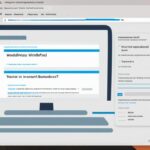Table of Contents
In this guide, we will walk you through the process of adding a link on WordPress. Whether you want to embed hyperlinks, create text links, add links to images, buttons, or menus, we’ve got you covered. By mastering these link-building techniques, you can enhance your website’s functionality and improve user experience.
When it comes to adding a link on WordPress, there are several methods you can use. To start, you can easily add a link via the link button in the dashboard. Simply highlight the desired text, click the link icon, and enter the URL or choose content from your own site.
If you want to link to existing site content, copy the URL you wish to link, highlight the text, and paste the URL directly onto it. Alternatively, utilize the “[[” keyboard shortcut to quickly select a recently published page or post to link to.
You also have the ability to edit a link, allowing you to change the text or URL. Additionally, you can customize link attributes such as opening in a new browser tab, marking a link as nofollow, or removing a link from your site altogether.
How to Add Links in Different Areas of Your WordPress Website
In WordPress, you have the flexibility to add links in various areas of your website, ensuring an interactive user experience. Let’s explore how you can add links to your WordPress posts and pages, widgets, and navigation menus.
Adding Links to Posts and Pages
When creating or editing a post or page in WordPress, adding a link is straightforward. Simply follow these steps:
- Edit the post or page where you want to add the link.
- Highlight the text or image you want to make into a link.
- Click the link button in the editor toolbar.
- Enter the URL you want to link to or search for content on your site.
- Click Save or Update to save the changes.
Note: Alternatively, you can paste the URL directly onto the anchor text to create a link quickly.
Adding Links to Widgets
Widgets are a great way to enhance the functionality of your WordPress website. To add links to widgets, like the sidebar, follow these steps:
- Go to the Appearance section in the WordPress dashboard and click on Widgets.
- Find the widget area where you want to add the link.
- Add a Paragraph widget to the desired widget area.
- Enter the text and link URL in the Paragraph widget.
- Click Save to apply the changes.
Navigation menus play a crucial role in guiding visitors through your website. Here’s how you can add links to navigation menus:
-
In the full site editor:
- Go to the Appearance section in the WordPress dashboard and click on Menus.
- Click on the Add button in the navigation block.
- Enter the URL and label for the link.
- Click Add to Menu to add the link to your menu.
-
In classic themes:
- Go to the Appearance section in the WordPress dashboard and click on Menus.
- Select the posts or pages you want to add to the menu.
- Add them to the menu by clicking the Add to Menu button.
- Drag and drop the menu items to arrange their order.
- Click Save Menu to save the changes.
Adding links in different areas of your WordPress website allows you to provide seamless navigation and enhance user engagement. Take advantage of these features to create an interactive online presence and drive traffic to specific content.
By integrating links strategically throughout your website, you can improve the user experience and boost your SEO efforts. Whether it’s directing readers to related posts in your blog or promoting important pages in your menu, effective linking can help enhance your website’s overall performance.
Conclusion
Adding links to your WordPress website is essential for improving site navigation and enhancing user experience. By following the step-by-step guide provided, you can easily embed hyperlinks into your posts, pages, widgets, and navigation menus, thus increasing the accessibility and usability of your website.
When adding links, it is crucial to use descriptive text that accurately represents the linked content and avoids generic phrases such as “click here.” This helps in providing valuable information to your visitors and improves the overall user experience.
WordPress offers a range of options for adding links, including creating text links, adding links to images and buttons, and customizing link attributes like opening in a new tab or marking as nofollow. This flexibility allows you to have complete control over your website’s linking structure, giving you the opportunity to enhance the functionality and user-friendliness of your WordPress site.
By incorporating well-placed and relevant links throughout your website, you can create a seamless and intuitive navigation experience for your audience. Invest time in optimizing your site navigation through thoughtful linking strategies and watch as your WordPress website becomes more engaging and user-friendly.
tag). These tags should be used in the list: ,
How can I add a link on WordPress?
To add a link on WordPress, you can use the link button in the dashboard. Simply highlight the text you want to link, click the link icon, and enter the URL or search for content on your site. Alternatively, you can copy the URL you want to link, highlight the text, and paste the URL directly onto it. Another option is to use the [[ keyboard shortcut to select a recently published page or post to link to. You can also edit a link by changing the text or URL, set a link to open in a new browser tab, mark a link as nofollow, or remove a link from your site altogether.
Where can I add links on my WordPress website?
In WordPress, you can add links in various areas of your website. When adding links to posts and pages, simply edit the post or page, highlight the text you want to make a link, click the link button, and enter the URL. You can also paste the URL directly onto the anchor text to create a link quickly. To add links in widgets, such as the sidebar, you can use the Paragraph widget and enter the text and link URL. Adding links to navigation menus is easy too. In the full site editor, you can add links by clicking the Add button in the navigation block, or in classic themes, you can select posts or pages and add them to the menu.
Why is adding links important for my WordPress website?
Adding links to your WordPress website is crucial for improving site navigation and user experience. By embedding hyperlinks into your posts, pages, widgets, and navigation menus, you can enhance the functionality and user-friendliness of your site. Remember to use descriptive text for your anchor text instead of generic phrases like “click here.” With the ability to create text links, add links to images and buttons, and customize link attributes such as opening in a new tab or marking as nofollow, you have full control over your website’s linking structure.
Reminder: The headline FAQ should be enclosed in an H2 tag ( only in
. Use Q: in
and A: in
.







